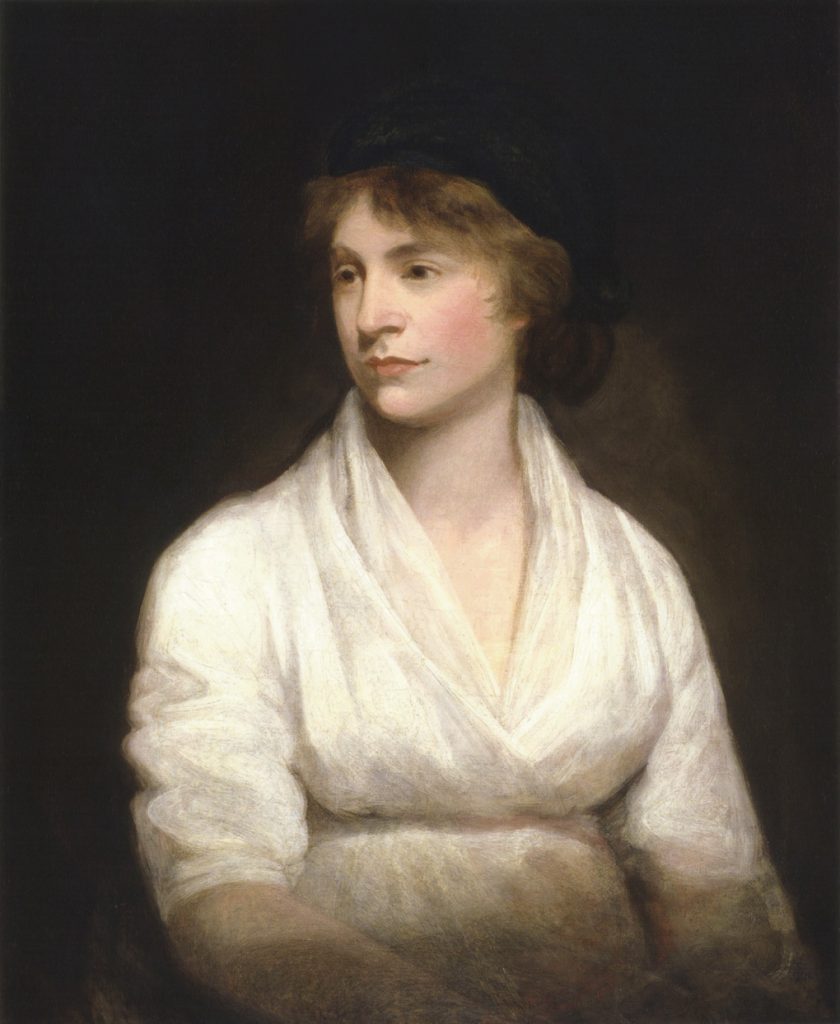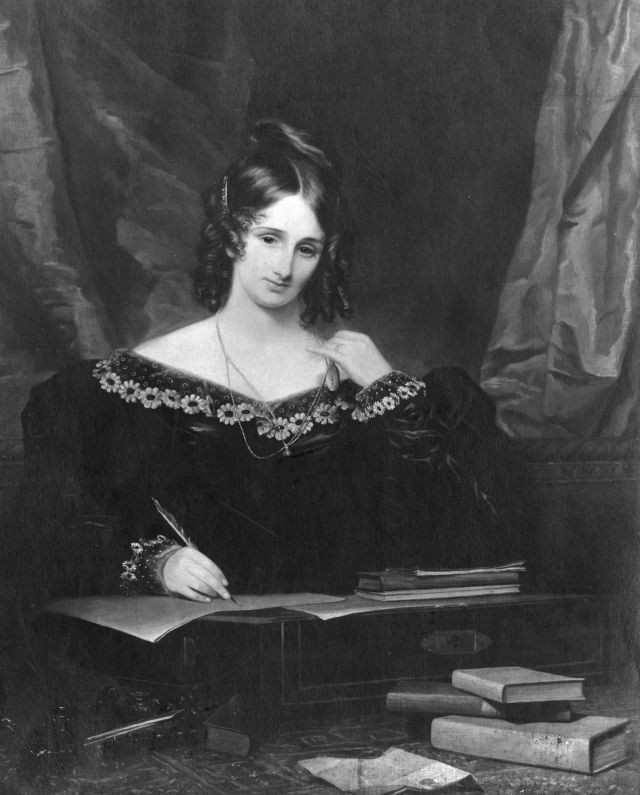Writer, philosopher, and women’s rights advocate, Mary Wollstonecraft wrote many novels and treatises along with a travel narrative, a history of the French Revolution, and more. She is best known for her 1792 work, A Vindication of the Rights of Woman, one of the first earliest pieces of feminist philosophy. Wollstonecraft suggested that women were, unlike popular opinion at the time, not inferior to men, but due to their lack of education, they appeared to be. She died a week and a half after the birth of her second daughter when she was thirty-eight. Her second daughter, Mary Wollstonecraft Godwin, better known as Mary Shelley, was the acclaimed author of Frankenstein.
On April 27, 1759, Mary Wollstonecraft was born in Spitalfields, London to Elizabeth Dixon and Edward John Wollstonecraft, the second of their seven children. As a child, her family made a decent income to live a comfortable life, but Wollstonecraft’s father spent much of it on speculative projects, leaving the family financially unstable. Throughout her childhood, the family moved often due to their financial instability. Eventually they reached a point where they were so in need of money, that Edward Wollstonecraft had to convince his daughter to turn over the money she would have inherited. Not only was Edward Wollstonecraft a reckless spender, but he would also beat his wife whenever he got too drunk. Mary Wollstonecraft would lay outside her mother’s door at night to protect her when her father would beat her. She also played a maternal role towards her two younger sisters, Everina and Eliza, as well.
As a girl, Wollstonecraft was shaped by her good friend Jane Arden, who lived in Beverly. The pair red books together and attended Arden’s father’s lectures. Wollstonecraft loved being around the Arden’s because of the intellectual atmosphere of their home, as Mr. Arden was a philosopher and scientist. As an adult, Jane Arden went on to be a school teacher.
Along with Jane Arden, Wollstonecraft was also close with Frances “Fanny” Blood, who she credited with opening her mind. Wollstonecraft also moved in with the family for a few years later on. She had left home in 1778 and took up a job as a lady’s companion for a widow in Bath named Sarah Dawson. Wollstonecraft did not get along with Dawson and returned home after two years to take care of her sick mother. When her mother died, she did not go back to work for Dawson, but instead moved in with the Bloods.
Wollstonecraft and Blood had envisioned a female utopia together. They planned on renting rooms together while supporting each other both emotionally and financially. Due to their economic situations, their dream was crushed. Wollstonecraft’s sisters helped her and Blood set up a school located in Newington Green, which was a dissenting community. But when Blood got engaged and married Hugh Skeyes, she moved to Lisbon, Portugal in hopes of improving her poor health. So, Wollstonecraft left the school when Blood’s health worsened after she got pregnant to try and care for Blood. She was devastated when her good friend died in 1785. This also led to the school’s failure. Blood’s death inspired part of Wollstonecraft’s first novel, Mary: A Fiction, as well.
With help from friends, Wollstonecraft was able to secure a job as a governess for the Kingsborough family’s daughters after Blood’s death. She had trouble getting along and agreeing with Lady Kingsborough, but the kids thought her to be very inspiring as an instructor. When Wollstonecraft wrote a children’s book in 1788, she took some of the experiences from her time with the Kingsborough’s and put them into the book, Original Stories from Real Life.
However, Wollstonecraft found herself more and more frustrated with her career options. As a woman of her times, she hardly had any options for a career compared to men. And on top of that, she did not have much money, which limited her choices even more. She talked about this in one chapter of her 1787 book Thoughts on the Education of Daughters. It was published not long after she left her job as a governess after only a year and was her first published work. That same year, Wollstonecraft wrote to her sister Everina expressing that she wanted to become “the first of a new genus”. Soon, she had moved to London where Joseph Johnson, a liberal publisher, helped her find a place to live and somewhere to work so she could support herself while still writing. Wollstonecraft was taught German and French as she began translating books. Along with that, she also started reviewing books. On top of all that, Wollstonecraft was able to meet many more intellectuals by attending Johnson’s dinners. For example, she met Thomas Paine, the pamphleteer who is most well known for Common Sense, and William Godwin, a philosopher and her future husband. Though they would later marry, the two were at first disappointed in each other when they met.
Wollstonecraft began to pursue a relationship with Henry Fuseli, the already married artist, while she was living in London. When she had suggested a platonic living arrangement with her and the Fuseli family, his wife was appalled. After that, Fuseli put an end to his relationship with Wollstonecraft. She was humiliated after all that happened and planned a trip to France. Another reason for the trip was to participate in revolutionary events, such as the ones she had been celebrating in her 1790 book Vindication of the Rights of Men. It had been written as a response to Reflections of the Revolution in France by Edmund Burke in which he criticized the French Revolution. Wollstonecraft quickly became famous over it and soon wrote her most notable and influential work, A Vindication of the Rights of Woman in 1792.
In December of 1792, Wollstonecraft left London for Paris. Louis XVI was to be guillotined about a month after her arrival. She began seeking out others visiting from Britain, writer Helen Maria Williams. Wollstonecraft was determined to put the ideas from Rights of Woman to the test in Paris, including an experimental romantic attachment. She quickly fell in love with American Gilbert Imlay. Wollstonecraft may or may not have been interested in marrying him, but he was not. And though she had disagreed with the sexual parts of a relationship, that seemed to be the opposite when she met Imlay. Not long after they fell in love, she got pregnant, and on May 14, 1794, she gave birth to her first daughter, Frances “Fanny”, perhaps named after her close friend Frances “Fanny” Blood. Upon the birth of Fanny, Wollstonecraft was overjoyed. Though being a mother in a new country was a burden at times, Wollstonecraft did not give up writing. She was staying in northwestern France in Le Harve when she wrote a history of the early parts of the French revolution called A Historical and Moral View of the French Revolution. This was published at the end of 1794 in London.
France’s political situation was only getting worse, and soon, Britain declared war. This put not only Wollstonecraft, but all British subjects in France, in even more danger. In 1793, before their daughter was born, Imlay registered her as his wife (despite the fact that she was not) to protect her. Wollstonecraft watched some of her friends be arrested, and some even guillotined. Meanwhile back in England, her sisters believed her to be imprisoned. Imlay eventually left her though because he was unhappy with her domestic and maternal mindedness. Once she was back home, she continued to call herself Mrs. Imlay, even to her sisters, to give her daughter legitimacy.
Wollstonecraft left France in April of 1795, still seeking out Imlay. He rejected her though, which led to her attempting suicide the following month. It is not known how he saved her, but Imlay did save her from dying. She made one last attempt to win him back by going to Scandinavia for some business negotiations on his behalf. The hazardous trip was made by Wollstonecraft herself with her baby daughter and a maid. Accounts of her travels and letters to Imlay were later put in Letters Written During a Short Residence in Sweden, Norway, and Denmark in 1796. By the time she arrived back home, Wollstonecraft realized there was no more chance for a relationship with Imlay, and once again, she attempted suicide by jumping into the River Thames. A stranger saw her jumping and was able to rescue her, so she lived.
She was able to recover and rejoined Joseph Johnson’s circle, becoming close with Mary Hays, Elizabeth Inchbald, and Sarah Siddons. At the same time, she started courting William Godwin. What started off as a slow courtship soon became a love affair full of passion. Wollstonecraft was soon pregnant once more, and the couple decided to quickly get married. Their marriage also revealed that Wollstonecraft had never been married to Imlay, and the both of them lost many friends over that. And on top of that, Godwin had advocated for marriage to be abolished in his treatise Political Justice, so when he went against what he had written and got married, he lost many more friends as well. Their marriage was on March 29, 1797 and after that, they moved into two houses that were adjoined they called The Polygon. This was so they could both maintain their independence and often times, they would communicate through letters. Though it was short, they lived a happy and stable life together.
Wollstonecraft gave birth to Mary Wollstonecraft Godwin on August 30, 1797, her second daughter. Mary would go on to marry Percy Shelley and write many novels, including Frankenstein, under her married name of Mary Shelley. While the birth went smoothly at first, the placenta ended up breaking and was infected. At the time, it wasn’t uncommon for women to get childbed fever and die from childbirth. After eleven days spent suffering, Mary Wollstonecraft died at thirty-eight years old on September 10, 1797 of septicaemia. Godwin was devastated, writing to his friend, “I firmly believe there does not exist her equal in the world. I know from experience we were formed to make each other happy. I have not the least expectation that I can now ever know happiness again.” Wollstonecraft was buried in London in the Old Saint Pancras Churchyard. In 1851, however, her daughter Mary’s son, Percy Florence Shelley, moved her remains to St. Peter’s Church in Bournemouth where his family’s tomb was. When Godwin died in 1836, he was buried beside her, and his second wife was as well.
Not long after Wollstonecraft’s death in 1797, Godwin published her memoir the following January, titled Memoirs of the Author of A Vindication of the Rights of Woman. Godwin himself believed that he had portrayed his wife with love and compassion along with sincerity. However, many readers found themselves shocked when they realized he had written about her illegitimate children, love affairs, and suicide attempts.



